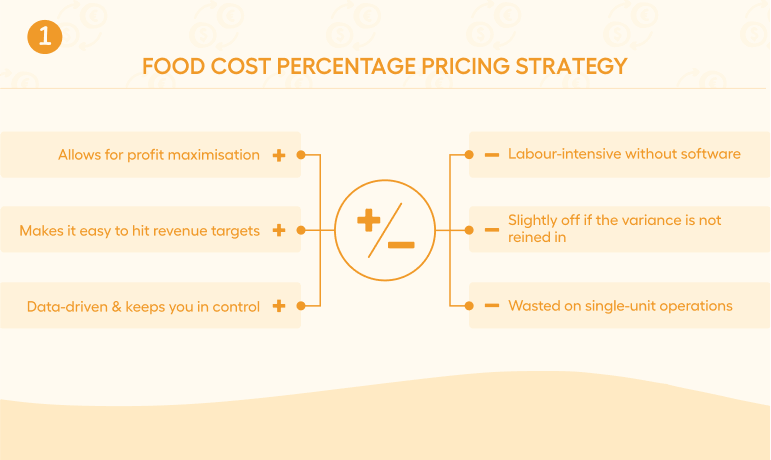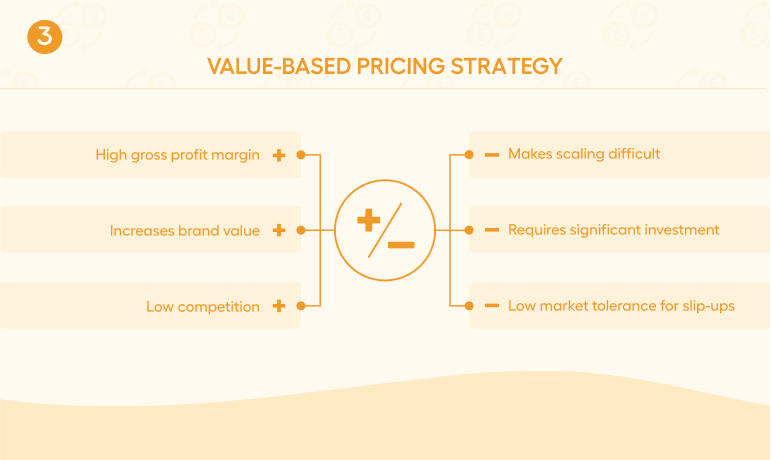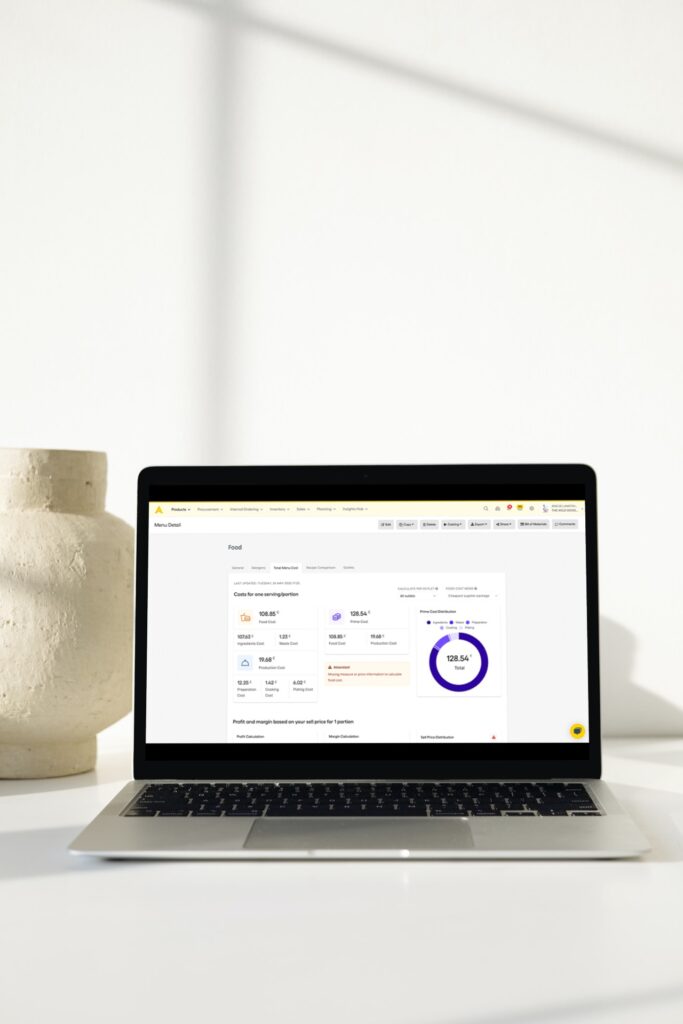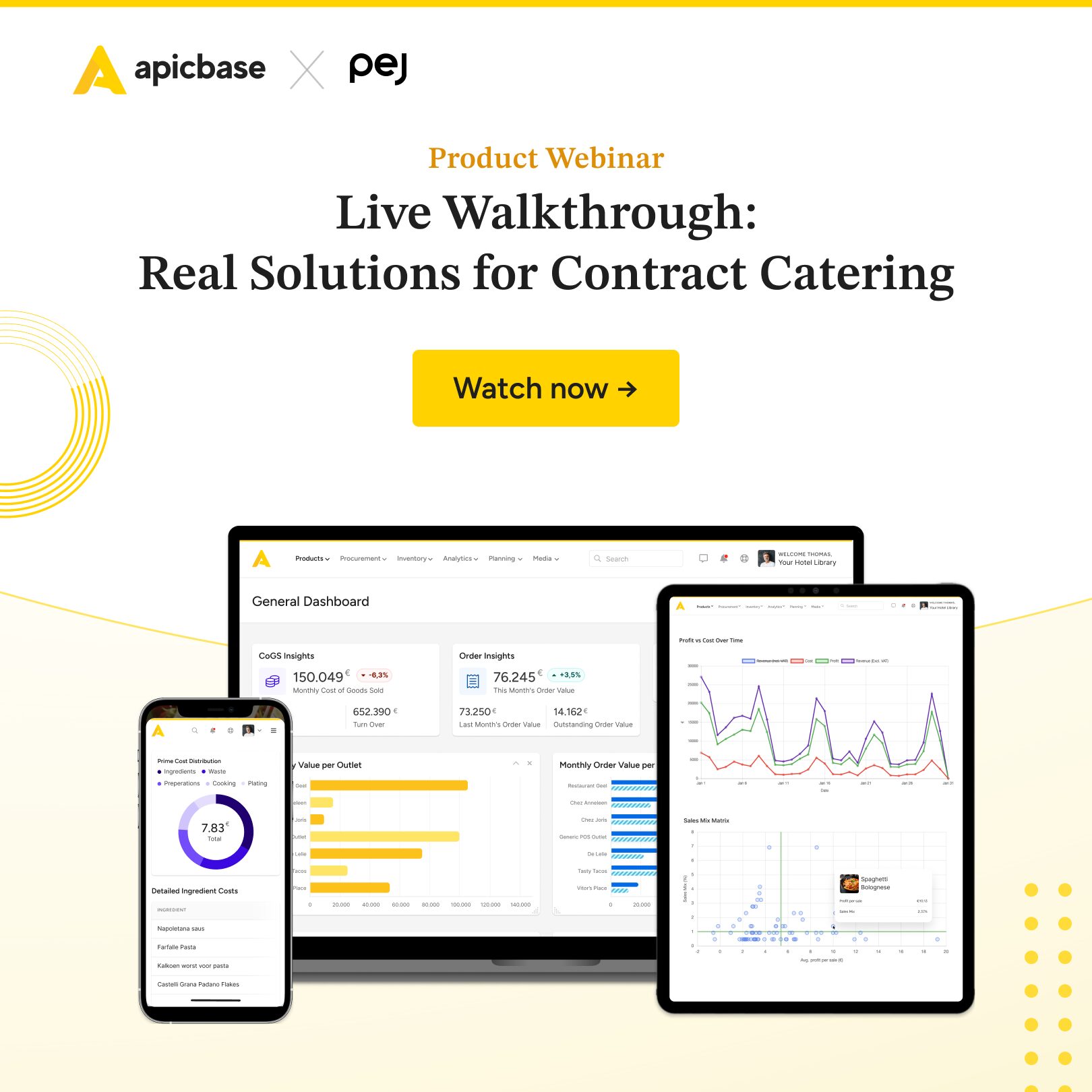As an F&B manager in a large multi-outlet operation [or a hotel chain], you’re used to focusing on the cost side of things. Shaving a percentage point off food costs here… eking out a few extra pennies by tightening up inventory procedures… stomping out waste.
Every little bit adds up, right?
But… there’s another side to the restaurant profitability equation — menu pricing.
What is menu pricing?
Menu pricing is the process of assigning a sales price to your menu items. This process should use predetermined restaurant KPIs (revenue goals, costs and other data) to optimise pricing, with profit maximisation being the end goal.
Unfortunately, in its strive for efficiency and leanness, the restaurant industry is still sleeping on data-driven menu pricing. A vast majority of operators either follow the leader in their market or, worse, price on intuition… leaving oodles of money on the table.
But, there’s an upside to this haphazard approach. And that upside is that the road to profit maximisation that much easier for savvy operators… like yourself.
In this post, we’ll talk about F&B pricing strategies [i.e. how you set your prices with restaurant KPIs and other data in mind] and menu pricing tactics [i.e. how you make those choices work in day-to-day operation].
Whether you’re putting together a brand new menu or updating menu pricing across your organisation, the following steps will help you do so confidently and accurately. The best part? You won’t be basing your prices on guesswork and hunches.
4 F&B Menu Pricing Strategies

There are several different strategies you can opt for when setting your restaurant’s menu prices.
However, only one strategy — the food cost percentage pricing strategy — puts you in the driver’s seat of your operation. Other strategies, such as competition and value-based, don’t give you the same level of control and manoeuvrability on your road to maximising profits.
I’ll list out the pros and cons for each of these so you can make an informed decision. But first, let’s take a look at the one strategy that’s almost guaranteed to increase your restaurant’s profitability.
Food cost percentage pricing wins the day
This menu pricing strategy gives you the ultimate control over your operation.
You’re anchoring your prices to your ideal food cost percentage — the portion of sales you want to spend on ingredients and other raw materials. This number can vary wildly [between 15 to 35 per cent, depending on the type of restaurant operation you’re running], but you set it yourself.
The better you control your food cost variance — keeping to your ideal percentage or even getting below it — the better your net profit.
Here’s how to set your prices with this in mind:
- Decide on your ideal food cost percentage — choose a percentage point that will work for you based on your revenue goals. Stay realistic — if you’re running a string of fine dining restaurants, setting ideal food costs at 25% is frustrating… and unattainable. But, setting them at 32% [as opposed to 35%] gives you something to work towards.
- Cost out your menu items — determine the cost of your ingredients for each item on the menu. For example, for a salmon sandwich, you would factor in the salmon cut, bread, dressing, spices, and every other ingredient. Then you’d drill down to that item’s ideal food cost, also called the portion cost.
- Calculate prices for menu items — the formula here is simple: PRICE = PORTION PRICE OF AN ITEM / IDEAL FOOD COST PERCENTAGE. For demo purposes, let’s say your ideal food cost target is 31%, and your portion cost is $7.50. The recommended price would come out to $24.20 [Price $24.20 = Portion Cost $7.50 / Ideal Food Cost Percentage 0.31]. An expensive sandwich? Sure. But it’s priced just right.
Now…
When using this strategy, you need to dial in your menu costing first and keep your food cost variance at a minimum, or you won’t hit your target.
But don’t worry — instead of frantically crunching up the numbers every day to see if anything’s changed on the cost side of things, you can use Apicbase. Once set up, Apicbase can keep tabs on the cost of every item that leaves your kitchen in real-time. And when major fluctuations happen — such as market price hikes or vendors changing their pricing or packaging — the system will warn you so you can adjust your course-correct without taking a major hit.
Recommended reading: Restaurant Menu Costing — Automating Recipe Calculations with Apicbase

Cost plus markup pricing
With this method, you’re adding a markup to your Cost of Goods Sold. It’s straightforward, which is why a lot of operators use it. The idea is for the markup to cover your direct costs [like food costs and labour costs] and indirect costs and overhead expenses, and what’s left after is your net profit.

Value-based pricing
With this pricing strategy, you tie your prices to the value you provide, without necessarily looking at the cost side of the equation. This is primarily a high-end strategy reserved for fine-dining restaurants and premium hotel chains. Value-based pricing hinges on three things: strong marketing pull [Michelin stars, brand name, premium location], an exceptional experience, and access to the right customer base.

Competition-based pricing…
… is also dubbed ‘the lazy operator’s shortcut to restaurant menu pricing’. Execution is simple — get your hands on 10 menus from competitors near your locations, and use their numbers to formulate your prices. Not the most accurate of pricing strategies, but still relatively on point provided your competitors run a similar type of restaurant.

[COB] Get #1 Back of House Software: Manage Recipes, Purchasing, Inventory and Analytics All in One Place. Apicbase gives your teams the tools and data to reduce food costs and drive operational excellence across your restaurants.
5 Menu Pricing Tactics You Can Use to Drive Profitability
Now that you’ve decided on how you’re going to price your food menus, it’s time to pick up some tools that will help you:
- ‘sell’ those prices to your customer, and
- absorb any cost-side turbulence you run into.
Here are 5 restaurant menu pricing tactics that will serve you well in both those cases.

#1 Pick the right menu model for your operation
There are several different ways you can present your physical and/or digital menus. Depending on your goals and pricing strategy, you’ll want to make sure you choose the right one. Some of your options include promotion-based, upscale, limited, prix fixe, and menus organised by cuisine.
Figure out what’s most in line with what your brand stands for, and ensure that your menu design communicates that. For example, an upscale minimalistic menu is a right choice for a fine-dining establishment. For a fast-casual chain, you can’t go wrong with a promotion-heavy menu design.
#2 Use menu engineering to offset ingredient price fluctuations…
There’s nothing in the ‘running a restaurant operation’ rulebook that says you can’t change your prices every day. You can. Equally true, though, is that your customers can just choose to dine somewhere else if you pull the rug from under them too often.
To avoid giving people a whiplash injury every time they check the menu, play the ingredient balancing game called menu engineering. Mix higher-priced mains with cheap-to-make appetisers, side dishes, and desserts. When the price of prime meat cuts, fish, or poultry goes up, you won’t take a brutal hit because the other ingredients will keep the average cost palatable.
#3 … But don’t be afraid to re-evaluate your pricing as needed
I’m knowingly putting my foot in my mouth here, but…
… sometimes, you’re left with no choice but to adjust your selling prices.
While an increase in CoGS often comes down to excessive food waste or poor portion control [things that you can influence], this isn’t always true. When your menu cost is affected by outside things such as market fluctuations and vendor price hacks, a price change is often the only option left.
Word of advice here — stick to competitive and reasonable prices. Also, if your customer base is mostly regulars, have your servers explain the reason behind menu price changes.
#4 Leverage pricing design psychology
There are many menu psychology ‘tricks’ you can use when creating menu layouts — tricks that can complement your F&B pricing strategy and net you more sales. I won’t list all of them, but here are a few that will work regardless of the type of your F&B operation:
- Use price anchoring — add a few higher-priced dishes to your menu. Their hefty price will make everything else on there look like a sweet deal in comparison.
- Nest prices behind each menu item — add an item’s menu price in brackets right after the description. That way, the focus is on the food and the experience. Avoid trailing dash lines because they shift the focus from the food to the price tag.
- Use the golden triangle placement method — top left, middle, and bottom right are your menu’s sweet spots. It’s where you want to place all your highly profitable items because those are the places where people’s eyes go when they crack open a menu.
- Limit choices — ever heard of analysis paralysis? It’s that thing most people suffer from when faced with an abundance of choices. Nip it in the bud by focusing your offer and limiting to it 15 – 20 items. There’s one big caveat to this, though — people expect fast-casual restaurants to have a huge selection, so keep that in mind.
- ‘Humanise’ your menu items — use dish naming conventions and descriptions to make people feel something… to remember something. Studies show that customers will often go for a slice of ‘Grandma Alice’s Apple Pie’ even if they think it’s not going to be nearly as good as the ‘Tinned Peach Souffle with Ganache Filling’. Tap into that sentimentality
Your best bet here is partnering with a pricing psychology expert. Getting someone on board for even two hours could save you from costly menu design mistakes, especially in a multi-unit operation.
#5 Experiment with experiential offers
Some of your most expensive menu items might be an integral part of your offer — the thing you’re known for — but still be a tough sell. If you make a business decision to keep them, add a twist by turning them into an experience. Perhaps they come with a built-in sommelier? Tickets to an adjacent nightclub you run? Or happy hour prices at the bar? Add-ons like these can turn menu mysteries into menu starts by making the final price seem more palatable.
Tips on Menu Pricing for Ghost Kitchens
If you’re a ghost kitchen operator, your pricing is a different ballgame. You’ll find many tips on running a profitable ghost kitchen in this post on menu engineering for delivery app orders. But, I still want to leave you with 3 pricing tips that might tip the scales in your favour… especially now that the ghost kitchen landscape is rapidly shifting.
- Adjust pricing to offset delivery costs — while there’s good value in using food aggregator apps, it’s still true that most of them eat 20 to 30 per cent into your bottom line. Delivery is a service, so you should think about adjusting your base price to absorb some of that additional cost. Around 5 to 10 per cent is a good amount since that is still less than what the customer would tip had they gone out to eat.
- Create multiple virtual brands — this makes it easier to compete on price with other venues offering similar items. You can price anchor your sandwiches without that beef Stroganoff looking ridiculous on the list. Another upside of having multiple virtual brands is that you automatically increase your discoverability on apps such as Uber Eats and Deliveroo.
- Adopt the ‘good-better-best’ pricing method — unbundle your food menus when listing them. For example, let’s say you offer a sandwich with a side of fries and a soft drink. Your first tier offer is only the sandwich. The next step up is adding the fries for a small surcharge. And the third tier offer is sandwich + fries + drink. This way, the customers can choose the right deal for them… without checking out your competition.
Recommended reading: 6 Different Types of Ghost Kitchen Restaurants
Fix More Than Menu Pricing with Apicbase

Not having the ‘just right’ menu pricing strategy will rarely sink an F&B operation.
That extra 0.5 to 2 per cent in net profit that is lost? A few restaurants might go under because of it, but most will carry on, oblivious to the money they’re leaving on the table.
You don’t want to be in the oblivious group.
Those few percentage points could mean the difference between raising salaries for your staff… expanding to a new market… or finally pulling the trigger and turning your brand into a franchise.

Take menu pricing as seriously as you take cost control.
And if you want help with that — or any other facet of running your restaurant business — Apicabase is the only all-in-one platform for an airtight back-of-house.
Check out Apicbase modules here, and then set up your demo to see how we can make your job easier.


